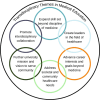Beyond the M.D.: Transdisciplinary approaches of high-volume dual degree M.D./Masters programs at U.S. allopathic medical schools
- PMID: 39014386
- PMCID: PMC11253467
- DOI: 10.1186/s12909-024-05709-3
Beyond the M.D.: Transdisciplinary approaches of high-volume dual degree M.D./Masters programs at U.S. allopathic medical schools
Abstract
Purpose: Transdisciplinarity has been described as a fusion of theories, methods, and expertise across disciplinary boundaries to address complex, global problems. This approach has coincided with an increase in US medical schools offering masters degrees along with an MD degree to equip medical students to practice in complex, interconnected health systems. This study focused on medical schools that graduate the most dual degree students per year and explored the alignment of such programs with a transdisciplinary approach.
Methods: We identified 19 allopathic medical schools that annually graduated an average of 10 or more dual-degree students from 2015-2020. We surveyed these schools and asked participants to describe the reason(s) their institutions offered dual-degree programs. Two authors coded the narrative responses from the survey.
Results: Responses were received from 17 of the 19 schools. The analysis of participants' responses regarding their institutions' purpose for offering dual programs revealed several themes associated with a transdisciplinary approach to training. The most common themes were expand skill sets beyond a medical degree (73%), provide opportunity for interdisciplinary collaboration (67%), expand career interest and goals (60%), develop leaders (53%), enhance residency applications (47%) and further the institution's vision and mission (45%).
Conclusions: This study is the first comprehensive evaluation of MD/Masters programs in the United States that includes a summary of the medical schools with the largest dual degree programs and their reasons for offering them. The findings support the hypothesis that allopathic medical schools recognize the need for a transdisciplinary approach to prepare students for the complexities in healthcare. These programs provide students with opportunities for additional areas of expertise, leadership development, enhancement of competitiveness for residency application, and interdisciplinary collaboration. Medical schools without dual-degree programs may consider developing these programs to provide benefits to students and institutions.
Keywords: Dual degree; Joint degree; Transdisciplinary.
© 2024. The Author(s).
Conflict of interest statement
The authors declare no competing interests.
Figures



References
-
- AAAS. ARISE II: Unleashing America’s Research & Innovation Enterprise. American Academy of Arts and Sciences; 2013 [accessed 2022 September 8]. Available from: https://www.amacad.org/publication/arise-ii-unleashing-americas-research....
-
- AAMC. Available from: https://www.aamc.org/data-reports/curriculum-reports/data/combined-degre.... Accessed 8 Feb 2022.
-
- AAMC. Data Warehouse, APP_BIO and STUDENT_IND tables. 2020 July 15 ed.
-
- Aerden AR, Hanna. Available from: https://ecahe.eu/wp-content/uploads/2021/06/Guidelines-for-Good-Practice.... [Accessed 2023].
MeSH terms
LinkOut - more resources
Full Text Sources

